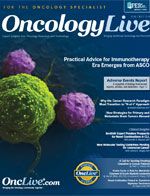Krebs Cycle: A Role for Metabolic Enzymes in Acute Myeloid Leukemia
One promising avenue of exploration of biomarkers in AML is the Krebs cycle, where inhibiting a key metabolic enzyme has proved beneficial in early clinical studies.
Alan M. Miller, MD, PhD
Chief of Oncology, Baylor Health System
Medical Director, Baylor Charles A. Sammons Cancer Center
Lorraine M. Cherry, PhD
Dallas, TX Writer and editor
Baylor Health System
Even with a growing body of knowledge about acute myeloid leukemia (AML), new biomarkers that would serve as prognostic indicators or therapeutic targets are urgently needed. One promising avenue of exploration is the Krebs cycle, where inhibiting a key metabolic enzyme has proved beneficial in early clinical studies.
The need for new therapies for patients with AML is pressing. The disease is the most common form of leukemia in adults, with approximately 18,860 new cases and 10,460 deaths expected to occur this year. It is largely a disease of older people, with more than half of patients 65 years or older at diagnosis. Treatment typically begins with administration of cytarabine and anthracycline induction chemotherapy to achieve remission, followed by multiple rounds of consolidation chemotherapy and possibly stem cell transplant.
AML is a heterogeneous malignancy, with distinct disease subtypes characterized by recurrent chromosomal translocations and somatic mutations. Subtypes are associated with different levels of risk. For example, monosomal karyotypes (-5, 5q-, -7. 7q-) are related to poor risk, while some specific translocations [t(16;16), t(8;21), t(15;17)] are associated with better risk. In addition to cytogenetics, molecular markers, including FMS-like tyrosine kinase 3 (FLT3), c-KIT, nucleophosmin (NPM1), and CEBPA, can help in defining prognostic groups.
Although researchers have been able to identify these subtypes, the prediction of relapse in a specific patient remains uncertain. The current best approach is to determine as early as possible if a patient has relapsed or if there was subclinical residual disease after treatment. This will help us understand the effectiveness of the treatment and make informed decisions about postremission strategies.
Isocitrate Dehydrogenase
For several years, researchers have been using next-generation sequencing techniques to identify new mutations. that might be useful as prognostic biomarkers or as therapeutic targets for AML. This led to the discovery that mutations in isocitrate dehydrogenase (IDH), a metabolic enzyme, exist in 10% to 20% of patients with AML, conferring a poor prognosis.
IDH is a critical enzyme in the Krebs cycle. It is present in two isoforms: IDH1 is cytosolic and IDH2 is mitochondrial. As homodimers, the IDH enzymes convert isocitrate into α-ketoglutarate (α-KG), which affects a variety of dioxygenases, including several that influence the epigenetic environment of the cell.
Mutations in IDH genes prevent oxidative decarboxylation of isocitrate to α-KG, affecting the overall energy landscape of the cell. In addition, IDH mutations result in conversion of α-KG to D-2-hydroxyglutarate (D-2-HG), which acts as a competitive inhibitor of dioxygenases. This leads to alterations in the epigenetic programming of the cell, blocking differentiation and potentially contributing to the development of AML.
Researchers have demonstrated that AMLs with mutated IDH1/2 show global hypermethylation and a specific hypermethylation signature. Inhibitors of IDH1 and IDH2 are currently in AML clinical trials with promising early results.
Potential Metabolic Effects of Mutations in Isocitrate Dehydrogenase (IDH)
Optical Isomers of 2-HG
The measurement of total 2-HG is straightforward, but small changes are difficult to detect against the background of normal variation, making it problematic for the use of disease monitoring. However, 2-HG is present as a mixture of two optical isomers. Optical isomers are molecules with the same sequence of atoms and bonds but with a different three-dimensional shape. They are functionally defined by the direction in which a plane of polarized light rotates when it passes through a solution of one of the isomers: D for dextrorotatory and L for levorotatory. Although optical isomers share the same physical properties (eg, melting points, boiling points, etc), their biological properties can be very different.
The hematologic malignancy team at Baylor Charles A. Sammons Cancer Center and Lawrence Sweetman, PhD, assistant director in the Center for Metabolomics, Institute of Metabolic Disease, Baylor Research Institute, in collaboration with clinicians from Scott and White Health, are undertaking a pilot project to measure both optical isomers of 2-HG in patients with IDH mutation—positive AML. If we can detect small variations in 2-HG, we may be able to determine earlier if a patient has had a relapse or whether there is minimal residual disease after treatment. We plan to study the ratio of the two isomers, as subtle changes in this ratio may be more sensitive than absolute concentrations to the presence of subclinical amounts of disease.
A specially designed two-dimensional gas chromatography column will be used to separate and accurately quantify both optical isomers by mass spectrometry with stable isotopically labeled internal standards. Both the D- and L-isomers will be measured, as well as the ratio between the two, to see if levels are correlated with the presence of the IDH1/2 mutation, if they are altered when the tumor burden is decreased, and if there is a correlation with treatment outcome. Dr Sweetman said: “There is an enormous literature implicating 2-HG in the development of these cancers, but we haven’t yet had the measurements we need to get a clear picture of what’s going on. The accurate measurement of the D- and L-isomers of 2-HG will help us to determine its real role in AML.”




